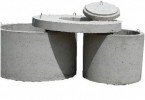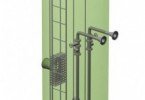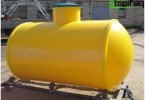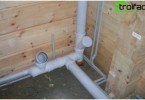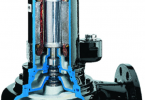The question of what a cesspool is and why it is needed is becoming more popular, because the number of owners of summer cottages and country cottages is steadily growing. Centralized sewage is not always convenient, therefore, to ensure a comfortable stay, you need to worry about the availability of all the benefits of civilization on your own. If you correctly approach this problem, the network will serve faithfully for many years..
Content
- Cesspool in a private house: advantages and disadvantages
- Varieties of cesspools
- Production without facing
- Tire structure
- Wooden formwork
- Brick cesspool
- With metal formwork
- Polymer formwork
- The most common concrete rings
It is noted that a cesspool in the country is the most common way to organize a sewer system. This is no coincidence. The principle of operation of the invention is simple: sewage, kitchen residues and used water flow down the pipeline into a drive located in the yard. As it is filled, specialized services clean up.
Cesspool in a private house: advantages and disadvantages
Any autonomous sewage has both pros and cons. The cesspool, of course, is no exception. Pros:
- environmental friendliness: sewage is discharged to drain stations; tightness of the drive, as cesspools without a bottom are prohibited by SNIP standards, prevents the pollution of groundwater and soil;
- ease of installation and operation;
- lack of dependence on the level of groundwater;
- lack of influence of soil type on the quality of operation.
Minuses:
- an unpleasant odor is possible, especially if a well is used. But with the use of plastic containers and a single chamber septic tank this can be completely avoided;
- the need for frequent calls to the sewer system. Owners of country houses should be aware that cesspools should be cleaned with permanent residence at least once every 2 weeks.
Varieties of cesspools
There are several ways to build cesspools, which differ only in the method of fastening the walls and the life time corresponding to this method.
Production without facing
It is used extremely rarely, because the walls quickly fall, reducing the usable volume. It is advisable to arrange such pits on limestone soils, but due to the fact that such soil is not common, structures without wall decoration do not differ in demand.
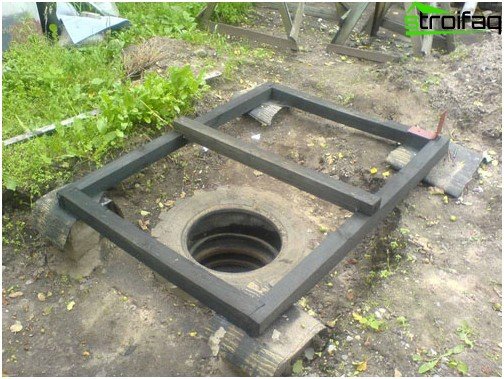
Tire structure
Car tire cesspool
This design will last about 30 years. It should be noted 2 nuances. First – the pit cannot be cleaned. The second – the filtration area – is the area of the hole in the tire, which, of course, is less than in any other option for the construction of drainage wells.
Accordingly, the bottom quickly silts and ceases to filter water. Before you build a pit out of tires – think carefully.
Wooden formwork
The service life depends on the type of wood and averages 7 years. Of course, it is unreasonable to let a good tree into such a thing, so these cesspools did not get wide distribution.
Brick cesspool
It will last about 15 years. It comes into disrepair due to the decomposition of wooden struts and bricks, which, with constant contact with water, turns into clay. But brick cesspools are repairable: if you wish, gradually replacing the brick with concrete inserts, you can extend the service life by another 50 years.
With metal formwork
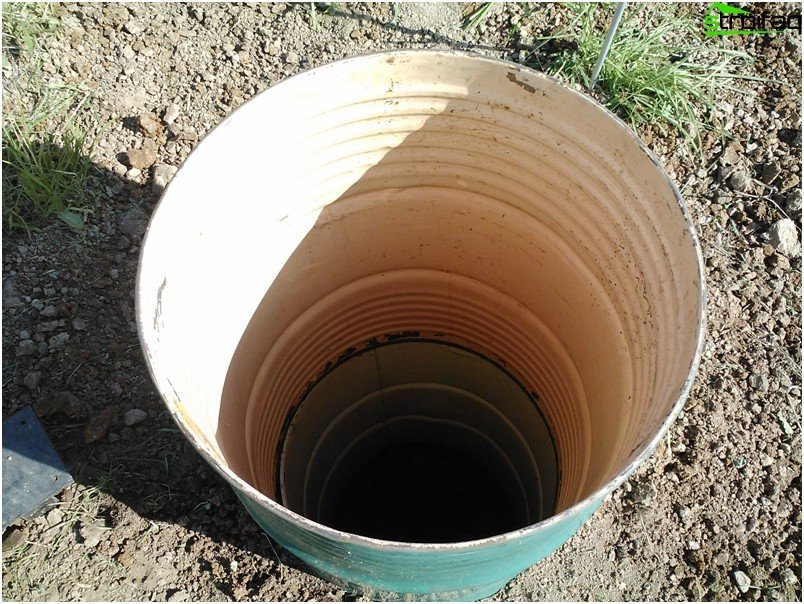
Cesspool of metal barrels
As in the situation with wood, performance is determined by the method of surface treatment and metal thickness. When using expensive materials, you can not know the worries for 60 years.
Polymer formwork
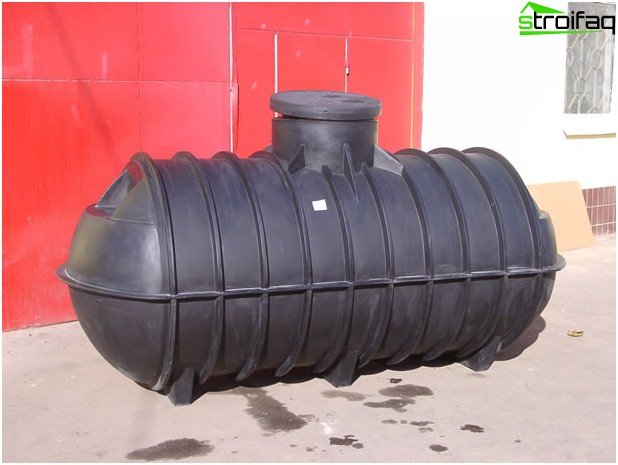
Plastic container for cesspool
Such designs are called “septic tanks” and are quite actively used in modern suburban construction. Innovations have both supporters who cannot be overjoyed at the acquisition, and opponents who criticize the achievement of innovative technologies.
The most common concrete rings
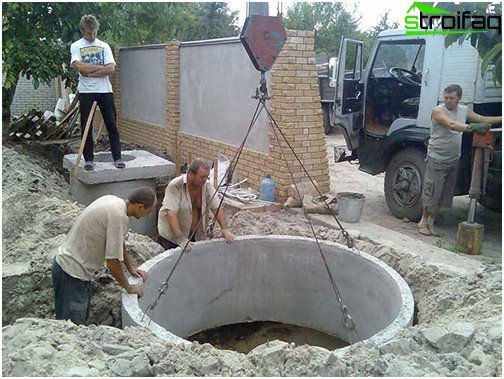
Concrete ring cesspool
Recognized as the best option for the price / quality ratio. Such a hole will last at least 100 years, pleasing with undeniable advantages: the absence of rotting and aging of the material and the ability of strong rings to withstand soil displacement.
Do-it-yourself cesspool: materials and work progress
The construction of a cesspool is a multi-stage process that requires strict adherence to a certain sequence.
Where to arrange a tank for receiving drains?
The pit should be built in such a way that it can easily be accessed by a sewage machine, which, incidentally, has impressive dimensions.
Important! The cesspool should be located at a distance of 5 meters from drinking water wells, residential buildings and plots with fruit trees. The distance from the fence should be at least 2 meters.

Cesspool: location calculation
Determining the location, you need to find out the depth of groundwater and get acquainted with the seasonal fluctuations. If the waters come closer to the earth’s surface closer than 2 meters, then the sump should be higher than the water intake line, and the pit should be equipped diagonally away from the source (25 meters).
Norms of volumes and sizes
Determine the volume of the future drive as follows. On average, 0.5 cubic meters is needed per person. This means that for a family of 5 people the cesspool should be at least 8 cubic meters. in volume. Suppose the residents of a country house use water heaters running on electricity. Then 1 person a day will spend about 150 liters of water. If the heaters are gas, then – 180 liters. The existing figure must be multiplied by the number of people living in the house. It turns out that the average family spends up to 700 liters of water per day (0.7 cubic meters).
The dimensions, again approximately, look as follows: the length of the cesspool – 3 meters, width – 1 meter, depth – 1.5.
Materials required for work
Once the dimensions and volume are determined, you can think about purchasing all the necessary materials. We will need:
1. Concrete. Lid volume + bottom volume. For preparation, you need 6 parts of crushed stone of medium fraction, 1 part of cement and 4 parts of sand. The amount of water is selected during the kneading process..
2. Brick. We calculate the height of the walls, divide by the height of the brick + 6 mm (seam) and get the number of rows. Then we find out the number of pieces in a row and multiply by 0.6 (for chess).
3. We obtain sand and cement when calculating points 1 and 2 automatically.
4. Fittings. For reinforcement, it is better to use reinforcement with a diameter of 12 mm or wire with a diameter of 8 mm. The reinforcement is laid with a square with a side of 30 cm.
You need to know! If you have old pipes or nets from beds, then they are perfect for reinforcing.
5. Tools: tape measure, building level, pegs, rope, shovel, buckets, concrete mixer, trowel, pickaxe and ladder.
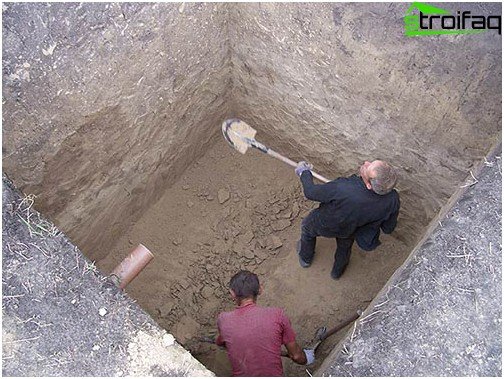
The first stage – earthwork
Cesspool device
Not sure how to make a cesspool? Then the following instruction will come in handy. Construction begins with the most time-consuming – excavation, which can take a week of time, if not more. The walls of the pit are leveled and protected, the bottom is designed with a slope towards the future hatch. The pit should be rectangular or square. A sand cushion 15 cm thick is arranged at the bottom, on which a layer of concrete of a similar thickness is laid. After the concrete sets (it usually takes 7 days), a cement-sand screed of 4 cm is made on it.
You need to know! The bottom can be made from a ready-made reinforced concrete slab, which is also placed at an angle.
We turn to the construction of walls. If you want to lay the walls with rubble stone or burnt brick, it is recommended to make a clay castle in advance. Bricks are laid on the basis of a sand-cement mortar. Walls should be plastered with the same cement-sand mortar..
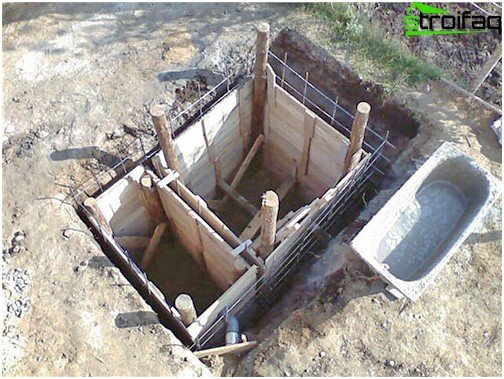
Cesspool device: formwork
It is important! Ironing will extend the life of the plaster, and covering the walls with bitumen mastic will prevent the risk of filtering..
The next step is the overlap device, which must be reliable. To do this, you need thick logs or a reinforced concrete structure: poles, plates, lintels. From the sides, the pit should overlap by at least 30 cm. During the work, it is important to leave a hole for the hatch with a size of 0.7 x 0.7.
To overlap, a formwork is made, the dimensions of which exceed the dimensions of the cesspool by 20 cm. Concrete is poured into it in 2 layers: first the first (7 cm), then the reinforcement is laid, with a spacing of 10 cm between the rods, and then the second layer.
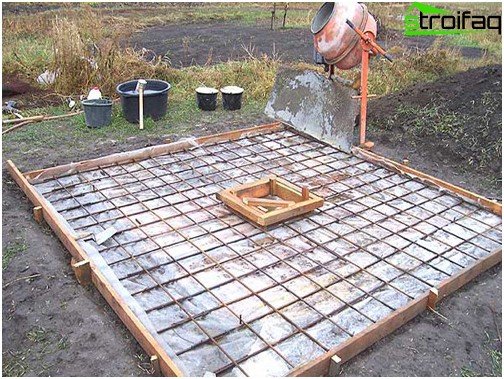
Cesspool: results of work
After the concrete has set, the prepared floor is covered with a waterproofing material, for example, plastic wrap or roofing material, and it is covered with soft clay, slag or soil from above. Manhole cover must be double. This will help prevent freezing in winter and the spread of bad smell in summer. The first cover is installed at ground level, the second at the floor level. The space between the covers is filled with expanded clay or slag, or laid with a heater of the appropriate size: pieces of foam or mineral wool. Top cover must be waterproof.
The work is completed: now you know how to make a cesspool – a reliable and environmentally friendly autonomous sewer of your own manufacture!


